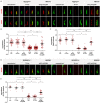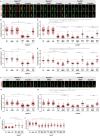Rpgrip1l controls ciliary gating by ensuring the proper amount of Cep290 at the vertebrate transition zone
- PMID: 33625872
- PMCID: PMC8108517
- DOI: 10.1091/mbc.E20-03-0190
Rpgrip1l controls ciliary gating by ensuring the proper amount of Cep290 at the vertebrate transition zone
Abstract
A range of severe human diseases called ciliopathies is caused by the dysfunction of primary cilia. Primary cilia are cytoplasmic protrusions consisting of the basal body (BB), the axoneme, and the transition zone (TZ). The BB is a modified mother centriole from which the axoneme, the microtubule-based ciliary scaffold, is formed. At the proximal end of the axoneme, the TZ functions as the ciliary gate governing ciliary protein entry and exit. Since ciliopathies often develop due to mutations in genes encoding proteins that localize to the TZ, the understanding of the mechanisms underlying TZ function is of eminent importance. Here, we show that the ciliopathy protein Rpgrip1l governs ciliary gating by ensuring the proper amount of Cep290 at the vertebrate TZ. Further, we identified the flavonoid eupatilin as a potential agent to tackle ciliopathies caused by mutations in RPGRIP1L as it rescues ciliary gating in the absence of Rpgrip1l.
Figures





Similar articles
-
The novel centriolar satellite protein SSX2IP targets Cep290 to the ciliary transition zone.Mol Biol Cell. 2014 Feb;25(4):495-507. doi: 10.1091/mbc.E13-09-0526. Epub 2013 Dec 19. Mol Biol Cell. 2014. PMID: 24356449 Free PMC article.
-
Role of DZIP1-CBY-FAM92 transition zone complex in the basal body to membrane attachment and ciliary budding.Biochem Soc Trans. 2020 Jun 30;48(3):1067-1075. doi: 10.1042/BST20191007. Biochem Soc Trans. 2020. PMID: 32491167 Review.
-
TMEM67 is required for the gating function of the transition zone that controls entry of membrane-associated proteins ARL13B and INPP5E into primary cilia.Biochem Biophys Res Commun. 2022 Dec 25;636(Pt 1):162-169. doi: 10.1016/j.bbrc.2022.10.078. Epub 2022 Oct 27. Biochem Biophys Res Commun. 2022. PMID: 36334440
-
CEP162 is an axoneme-recognition protein promoting ciliary transition zone assembly at the cilia base.Nat Cell Biol. 2013 Jun;15(6):591-601. doi: 10.1038/ncb2739. Epub 2013 May 5. Nat Cell Biol. 2013. PMID: 23644468 Free PMC article.
-
The Ciliary Transition Zone: Finding the Pieces and Assembling the Gate.Mol Cells. 2017 Apr;40(4):243-253. doi: 10.14348/molcells.2017.0054. Epub 2017 Apr 12. Mol Cells. 2017. PMID: 28401750 Free PMC article. Review.
Cited by
-
Renal Ciliopathies: Sorting Out Therapeutic Approaches for Nephronophthisis.Front Cell Dev Biol. 2021 May 13;9:653138. doi: 10.3389/fcell.2021.653138. eCollection 2021. Front Cell Dev Biol. 2021. PMID: 34055783 Free PMC article. Review.
-
Prenatal phenotype analysis and mutation identification of a fetus with meckel gruber syndrome.Front Genet. 2022 Aug 19;13:982127. doi: 10.3389/fgene.2022.982127. eCollection 2022. Front Genet. 2022. PMID: 36061204 Free PMC article.
-
In vitro modeling and rescue of ciliopathy associated with IQCB1/NPHP5 mutations using patient-derived cells.Stem Cell Reports. 2022 Oct 11;17(10):2172-2186. doi: 10.1016/j.stemcr.2022.08.006. Epub 2022 Sep 8. Stem Cell Reports. 2022. PMID: 36084637 Free PMC article.
-
Structure, function, and research progress of primary cilia in reproductive physiology and reproductive diseases.Front Cell Dev Biol. 2024 Jun 3;12:1418928. doi: 10.3389/fcell.2024.1418928. eCollection 2024. Front Cell Dev Biol. 2024. PMID: 38887518 Free PMC article. Review.
-
Composition, organization and mechanisms of the transition zone, a gate for the cilium.EMBO Rep. 2022 Dec 6;23(12):e55420. doi: 10.15252/embr.202255420. Epub 2022 Nov 21. EMBO Rep. 2022. PMID: 36408840 Free PMC article. Review.
References
-
- Aubusson-Fleury A, Lemullois M, de Loubresse N, Laligné C, Cohen J, Rosnet O, Jerka-Dziadosz M, Beisson J, Koll F (2012). The conserved centrosomal protein FOR20 is required for assembly of the transition zone and basal body docking at the cell surface. J Cell Sci 125, 4395–4404. - PubMed
Publication types
MeSH terms
Substances
LinkOut - more resources
Full Text Sources
Other Literature Sources
Molecular Biology Databases

